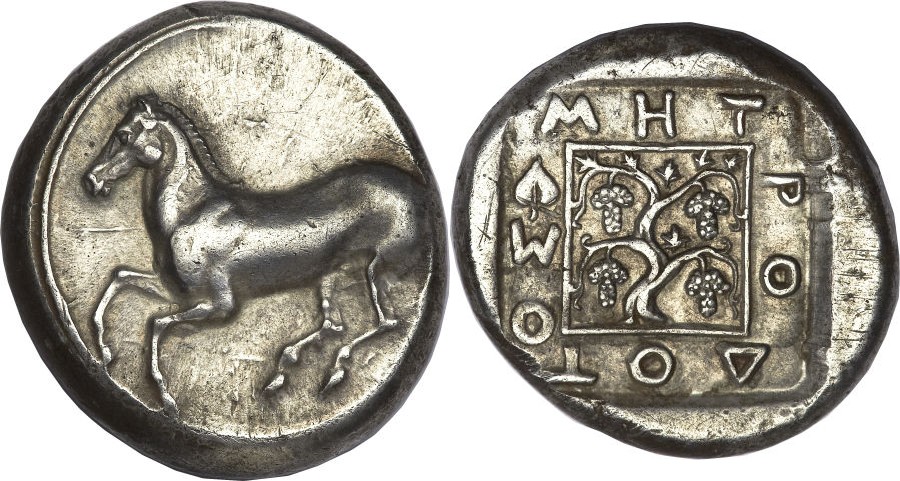AC 136 - Maroneia, silver, staters (411/0-398/7 BCE)
From SILVER
411 BCE - 398 BCE Silver 13,269 kg
Description
| ObverseInscription or printing placed on the obverse.: | Prancing horse left, without bridle. |
| ReverseInscription or printing placed on the reverse.: | MHT-PO-ΔOT-OM (Greek).Ivy leaf around square linear frame enclosing vine with four grapes-clusters, all within shallow incuse square. |
Mint and issuing power
| MintIdentifies the place of manufacture or issue of a numismatic object.: | Maroneia | Ancient regionAncient region.: | Thrace | Modern countryModern country: Greece | AuthorityIdentifies the issuing power. The authority can be "pretended" when the name or the portrait of X is on the coin but he/she was not the issuing power. It can also be "uncertain" when there is no mention of X on the coin but he/she was the issuing power according to the historical sources: |
Chronology
| FromIdentifies the initial date in a range assigned in a numismatic context. | 411 BCE | toIdentifies the final date in a range assigned in a numismatic context.. | 398 BCE | PeriodTime period of the numismatic object.: Classical 480-323 BC |
Physical description
| MetalThe physical material (usually metal) from which an object is made.: | Silver |
Median weightMedian of the weights of numismatic objects (in grams). in grams | 12.85 | DenominationTerm indicating the value of a numismatic object. Examples: tetradrachm, chalkous, denarius.: | stater |
StandardStandard.: |
Image

AC136 Maroneia.jpeg [1]
References
| Die study referencePublication of the study: | Schönert-Geiss 19871Schönert-Geiss 1987, n° 154-72 | ||
| Coin series referenceReference to coin series study: | RQEMAC2RQEMAC, n° 136 | ||
Obverse dies distribution
| FrequencyFrequency of specimen in distribution. ᵖ | Number of obversesNumber of obverse dies. ᵖ (o) | % (o) | Number of coinsNumber of coins. (n) | % (n) | Die nameName(s) of the die(s). |
| 1 | 13 | 76.47 | 13 | 56.52 | 1, 2, 4, 5, 6, 8, 9, 10, 11, 13, 14, 16, 17 |
| 2 | 2 | 11.76 | 4 | 17.39 | 3, 12 |
| 3 | 2 | 11.76 | 6 | 26.09 | 7, 15 |
| Total | 17 of 17 | 99.99 | 23 of 23 | 100 |
Reverse dies distribution
no distribution is available
Quantification
| Number of obversesNumber of obverse dies. ᵖ (o) | 17 | Number of singletons (o1)The number of singleton coins. ᵖ | 13 |
| Number of reverse diesNumber of reverse dies. (r) | 17 | Number of coinsNumber of coins. (n) | 23 |
| Coins per obverse dieNumber of coins per obverse die. (n/o) | 1.35 | Coins per reverse dieNumber of coins per reverse die. (n/r) | 1.35 |
| Reverse per obverse ratioRatio of obverse dies divided by reverse dies. (r/o) | 1 | Percentage of singletons (o1)number of coins (n) divided by the number of singletons (o1) ᵖ | 76.47 % |
| Original number of dies (O) (Carter 1983 formula)The estimation of the number of coins according to Carter 1983 ᵖ | 51.63 | Coins struck if 20,000 as average productivity per dieCoins made if the average productivity for obverses (according to Carter) is 20,000. ᵖ | 1,032,600 |
| Original number of dies (O) (Esty 2011 formula)The estimation of the number of coins according to the singleton formula in Esty 2011 ᵖ (O) | 65.17 | Survival rate if 20,000 as average productivity per dieSurvival rate if average productivity is 20,000. ᵖ | 0.00002 |
| Coverage (o = % of O) (Esty 1984 formula)Esty 1984 - coverage (% of O) ᵖ (o = % of O) | 43.48% | Die productivity if survival rate 1/2,000Average productivity if survival rate is 1/2,000. ᵖ | 890.95 |
| Weight of silver (in kg) if 20,000 coins per die (O = Carter formula)Carter 1983 * Median weight * 20000 (*10 if gold or electrum) ᵖ | 13,269 kg <br /> 13,269 kg | Die productivity if survival rate 1/5,000Average productivity if survival rate is 1/5,000. ᵖ | 2,227.39 |
Remarks